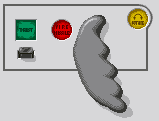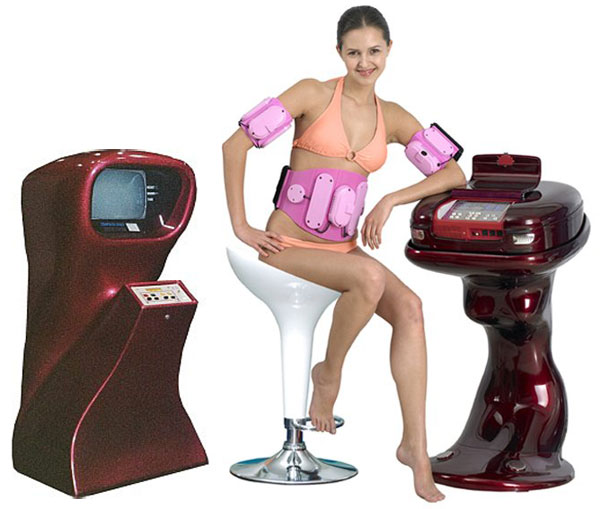
Random
If you watch the movie Jaws, about 40 minutes into the movie is an arcade scene where a kid is playing a Killer Shark game. Right beside it sits another yellow Computer Space.

Japanese Computer Space icons
I stumbled across a Japanese webpage which for some unknown reason had these png graphics of both versions of the Computer Space control panel. I have no idea why these were made and unfortunately the URL where I found them is no longer valid. The page used to be http://spitfire.client.jp/stg/history001.html but if you try to go there you get a 404 Error. The root of the page http://spitfire.client.jp is still up and running although since I cannot speak a word of Japanese I have no idea how to navigate back to the link with these graphics. Still, they are very nicely made (unfortunately these are not thumbnails, this is the actual size of the files I found).


It is interesting to note that the second graphic is of a version of the control panel only seen in this flyer. It is conceivable this may have been a preliminary idea for how to rotate the rocket which was then abandoned for simpler push buttons because no actual machine has ever been found (other than the one in this flyer) with such a control mechanism.
Computer Space, the movie star?
Apparently, Computer Space is a movie star. There is a listing for it on the Internet Movie Database, IMDb. Click on the screenshot to go to its listing.
The website I-Mockery (http://www.i-mockery.com/) put up a listing of the 50 Greatest Arcade Cabinets in Video History, in which they detailed many cabinets of the golden era of coin operated video games. Everything from ancient Pong to modern Dance Dance Revolution was considered and added to the ranks. Obviously, a beautiful cabinet such as Computer Space would make the list, but just how far up did it score? Click the image below to see the entire list.
Happy Birthday Nolan Bushnell
The popular website IGN posted an excellent article at the beginning of February 2008 to celebrate the 65th birthday of Nolan Bushnell. Computer Space is discussed as well as the formation of Atari and what projects Nolan is involved in today. Click on the image below to go to IGN's article.
Speaking of Nolan Bushnell and Atari, a game for the 2600 has come to light that closely resembles Computer Space (although it was played with paddles), it is called Warplock and was released by Data Age in 1982.
Click this thumbnail to go to the Atari Age page that details Warplock.
And click this thumbnail to visit the Atari Guide site where these graphics were taken from, plus be able to play Warplock in your browser.
Wallpapers
Following are a couple of wallpapers I have found on the web. The third I made by a few Photoshop adjustments.
They killed Computer Space! Separated at birth? Hmmmm you decide.
http://www.southparkstudios.com/
It appears Computer Space was missed at the Retro Con at VGXPO (formally known as Philly Classic). IGN posted an article on the sad latest showing of the exbition in November of 2008. The writer himself primarily used the article to lament over the passing of the traditionally awesome show and what machine does he mention as a former highlight?
Click image below to read the article.
Will Wright interviews Nolan Bushnell
On March 23, 2009, the European Games online magazine Develop ran an interview between Will Wright, creator of Spore and The Sims, and Nolan Bushnell. This was after Nolan recently received his BAFTA award (British Academy of Film and Television Arts), Will Wright was a previous recipiant and Develop Magazine thought it would be interesting to hear what both gaming giants would have to discuss. It turns out, they discussed Computer Space.


Click here to read the entire interview. The section regarding Computer Space has been reproduced below.
WW: I remember as a kid in the early ‘70s, at some point I was in New Orleans airport and I came across this thing called Computer Space, your first arcade game. It looked like an alien object which someone had dropped into the middle of the airport. A sleek fibreglass machine and all-electronic display. It was pretty much the first electronic game I had ever encountered in my entire life. And it pre-dated Pong, which I know was your more critical success. My question is: when you were making these things, did you have any inkling that this was a historic shift in mass entertainment? Or from your point of view were these weird experiment sorta ‘let’s try these out and see how they do’? Did you realise how significant these things were?
NB: The simple answer is that I didn’t realise the magnitude. I thought that this was going to be an important event and I felt it was going to be pretty big because it was really… I had so much fun and everyone I knew had so much fun playing computers on big mainframes – y’know, in the middle of the night when you could get computer time – that I just knew it had a resonant component to it.
So I always looked at myself as the guy who was going to make it cost-effective. It’s funny, I really felt that instead of a million dollar mainframe I was dropping the cost so anyone could do it. It was obvious to me that if the cost was right everybody would do it.
WW: And that’s a pretty significant drop in price – going from the mainframes down…
NB: Well, I actually started out thinking it was going to be a microcomputer connected to multiple terminals. And that was the design direction I had started going down. It wasn't until later that I realised that I could make a standalone unit. The early computer games – Computer Space and Pong – they weren’t built with an architecture at all.
They were just really great signal generators, just because you couldn’t… well, first of all the microprocessor hadn’t been invented yet! And the chips just didn't want to go fast enough to refresh at video rates and so we had to do all kinds of tricks to get the thing to work.
WW: In many respects it’s amazing they appeared when they did –
it seems like
they came out ten years earlier than they should have.
German museum of video game history uses Computer Space in intro
The Computer Game Museum in Berlin (Computerspielemuseum) opened in early 2011 carries an impressive collection of video games, both home versions and coin operated, inside. Their website has an introductory animation which showcases a two player Computer Space and its control panel.

Visit their website here and be sure to watch for the Computer Space animation.
As mentioned in May of 2011, Mike of Mechanical Arcade created one heck of a hack of a 2 Player Computer Space machine.
Discovered on this website regarding "Phone Arts" the following odd picture is merely captioned as Computer Space Game and Body Massage. Very random image.

Mattias who created the FPGA code for Computer Space decided that since he had all this hardware sitting around his desk, why not build a desktop version of Computer Space. It's simply amazing! And unfortunately before anyone asks, no this is not for sale and it is a one of a kind item. Too bad really, it would sell like mad! Click the thumbnail to see the machine playing or if you are a member of the Killer List of Videogame (KLOV forum) click here to be taken to the full discussion thread.
In the
summer of 2019, Ed Fries attended the North West Pinball and Arcade
show in Tacoma Washington and during his presentation on "Bronze Age
Arcade Games" (video)
he not only used slides from this very website (thanks Ed!) but he
also posted a rare photo of Nutting Associates employees assembling
Computer Space cabinets. I simply had to ask him where he got it. He
says it was in the Feb 12th 1972 issue of Cash Box Magazine.
